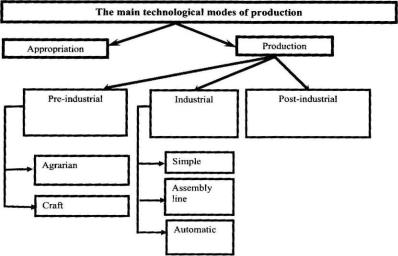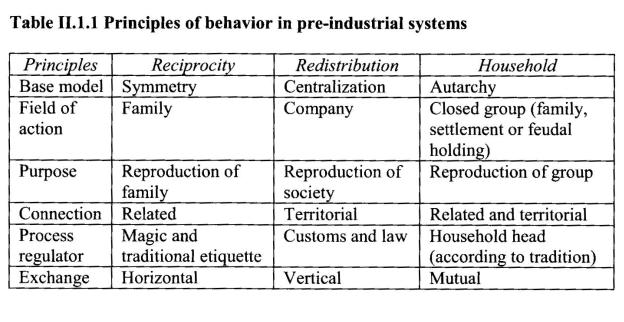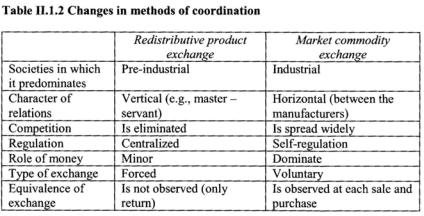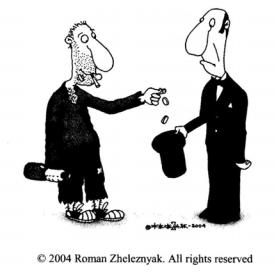
ИЭ НА АНГЛ
..pdfconditions needed to introduce them into economic practice. However, it is possible that technical innovations have an inverse effect on economic institutions.
The main theoretical principle of a new approach is the thesis about competition as the main content of economic history. This competition is traced in two manners:
•competition of institutions ('rules of the game');
•competition of economic systems - the sets of institutions.
During the competitive choice, a great many norms and systems compete, partially in order to replace one another. During the course of this competition, those institutions and economic systems which are the most effective are chosen. One criterion for the efficiency of competing institutions and systems is their ability to increase the welfare of the people - welfare in the broadest sense of the word (not only material, bat also intellectual; not only 'here and now', but also in a long-term respect).
The emergence of new institutions and economic systems can be an 'answer' to the 'challenge' of any external (natural) factors, but more often it is the result of the self-development of society.
Perfect institutions and economic systems can be selected in various ways - both unconsciously and consciously - with the application of violence (the less competitive institutions are destroyed during revolutions and backward systems perish in their struggle with more advanced ones) or in a peaceful manner (during economic reforms, the export of institutions and migration of resources). In the early phases of history, natural and violent competitive selection dominates, to be replaced by conscious and peaceful selection later. In an analogy to the theory of public choice and the problem of choosing the rules of decision-making, it is possible to speak about a competition of means of competitive choice as the highest level of competition in economic history.
It should be noted that (in keeping with the dependence on past development) the efficiency of institutions and systems can differ noticeably on a midand longterm basis. Therefore, norms and systems that initially win a competition can then lose their competitive potential and become deadlocked.
By virtue of the plurality of competing institutions and systems, the process of societal development is multi-linear:
•the different social systems compete (in particular, in the 20th century, the command industrial system with the market industrial system);
•the different civilizational and national systems compete (thus, in the 20th century - within a command system - Soviet, Chinese and EasternEuropean subsystems compete);
•within civilizational and national economic systems, various institutions compete (for example, in the 20"1 century in the US, direct, Keynesian, methods of economic regulation competed with indirect, neoclassical, ones).
Thus, economic history appears as a sequence of institutional choices - choices of development trajectories - and is achieved collectively by separate social groups and civilizations interacting with one another.
2. Institutional Choice
Institutional choice is a change in both formal and informal rules and also the means and efficiency of the enforcement of rules and limitations. The changes in formal rules (or in enforcement mechanisms) require rather significant costs in terms of resources that limit the capabilities of institutional choice. The economic subjects participate in institutional choice focusing their talents and knowledge on the search for new opportunities through establishing organizations (both final and intermediate) that act in economic and political areas, providing the required changes in formal rules. Economic changes to formal rules can occur rather quickly and suddenly if old institutions are broken down or temporarily neutralized (as happens during revolutions or conquests). More often, however, these changes occur in a slow, evolutionary way.
As for changes in informal rules, they are implemented gradually and the rate of change is very slow. Culture plays an important rule in this case (as the mechanism for transferring values and norms from one generation to another), as do contingencies and natural selection.
Organizations play an important role in institutional changes. An organization (in the broadest sense) is a group of the people, integrated in order to achieve a shared purpose. Pursuing the purpose of income maximization, the organization and its managers direct institutional changes. There are two main strategies for change: one is implemented within the framework of an existing set of limitations and the other requires a change in limitations.
The process of change usually actuates organizational experiments, and eliminates organizational errors. The problem, however, is: to what extent does the company control these organizational changes and to what extent is it interested in the elimination of organizational errors?
The long-term economic changes are, as a rule, the result of the accumulation of a set of short-term decisions on the part of political and economic agents. The choice, which is made by the agents, reflects their subjective opinions about the world. Therefore, the degree of conformity between the results and intentions depends on the correctness of these opinions. Since the behavioral models of people reflect their ideas, philosophy, beliefs (that, at the best, are only partially subjected to correction and improvement by feedback), the consequences of conscious decision-making are frequently not only uncertain, but also unpredictable. Therefore, historical process always supposes alternatives, though in a different measure and in various periods.
Notes
1In the Soviet Union, this direction of cliometrics, connected with primary attention to the correlation between climatic and social shifts, was picked up by L. Gumilev (1966), and then, in post-Soviet Russia, it was continued by E. Kulpin's school of socio-natural history.
2As for the theory of long waves (not only Kondratiev's), a lot of work has been done both abroad and in Russia (since 1980). However, this problem remains debatable. Some scientists (such as A. Frank) find long waves in primitive history, others (such as S. Solomou) doubt the very existence of Kondratiev's cycles for recent centuries (Poletaev and Saveljeva, 1993; Solomou, 1987; Frank, 1992).
3His book promotes, in Russia, the potential of the mathematical analysis of the primary historical data for processing information (Kovalchenko, 1987). One of his basic focuses in historical-mathematical research is studying regularities in the agrarian sector of the modern Russian economy. While studying the long-term dynamics of prices, he and his followers argued that, in pre-revolutionary Russia, there was a rather unified market for the main agricultural products, but the capital, labor and land markets developed much slower (see, for example: Kovalchenko and Milov, 1974). Under Kovalchenko's initiative, Russian-American symposiums have been conducted on cliometrics for historians since the end of the 1970s. Unfortunately, there is another domestic, popular version of quantitative history, which tends to discredit quantitative historical analysis. This is a 'new chronology' developed by A. Fomenko. It, too, is based on many relationships on quantitative methods for processing historical data (for example, on 'dynastic parallelisms'). The 'new chronology' has not only made a methodological error in the choice of the objects of historical-mathematical analysis, but also falsified the mathematical apparatus, when the solution is chosen before making analysis (see, for example:
Istorija i anti-istroija, 2001).
4The title of his article - 'Reunification of Economic History with Economic Theory' (Fogel, 1965) - is interesting.
According to North (1977), a new economic history is based on two cornerstones - neoclassical economics and quantitative methods.
Chapter II. 1
The Main Institutional Models of the Emergence and
Development of Capitalism
Rustem Nureev
Institutional models of the emergence and development of capitalism arose in opposition to mainstream economic thinking. Therefore, before describing these concepts, we shall briefly analyze the widespread approaches to the problems of development in a modern economic science.
§1: Economic Determinism and Institutionalists' Criticism
The economic determinism existing in the modern economic science is represented by two basic approaches: economic liberalism in its neoclassical form and primitive Marxism. As the influence of the first approach dominates, we shall begin our analysis with it.
1. Shortcomings of Neoclassical Approach to Researching Development
The dignity of neoclassical economics turns into its defects as soon as it tries to analyze problems of development. In the late 20th century, neoclassicism become mainstream economic thinking and tried to analyze not only the modern state of the economy, but also to draw a deduction concerning the economic development of the market economy on basic principles. Since the behaviour of the individual is conditioned by his nature, trade is a natural property of a person, much like his ability to speak or to drink. Moreover, as a result of the sequence of methodological individualism, the development of society is the result of actions of individuals, from which we can determine 'natural' laws of development. As in the modern world, the economic area dominates and the social and political connections are considered derivatives of this sphere of activity; it would be naive to believe that material interests determined the development of society at all stages of human development. Since it is supposed that the economy always aims at attaining an equilibrium, the interference of the State is considered a disturbance with respect to efficiency as well as second best in comparison with the first which arises automatically under perfect competition. Under this type of approach even simple innovations lead to a disturbance in the equilibrium and fundamental scientific research is only possible through State financing, i.e. overcoming market failure.
The advocates of neoclassical economics opposed the sharp interference of the State in the economy. In their opinion, such an approach is based on a weak understanding of economic processes and leads to large political changes that are
not all always favorable for the economy. The classical liberal approach, on the contrary, proceeds from an in-depth analysis of current processes, analyzing tendencies in economic development and does not require intense political changes. It is intended to create favorable conditions for market development which promote the discovery of potentials and opportunities concerning human development.
Although this picture only seems simplified, it stems from basic mainstream methodological assumptions. Even those mainstream economists, who were especially engaged in the problems of economic history, have to overcome this simplified picture.1
2. Marx's Approach and the Vulgarization of His Theory
It should not be forgotten that American and Western institutionalism developed as a response to the form of Marxism that existed in the late 19th and the first half of the 20th centuries. In retrospect, we can see that it was a certain parody of Marxism, although such a parody really existed and emerged not without the help of the followers of K. Marx.
The subject of Marx's research was material, socially organized, and historically conditioned production. He characterizes a mode of production as a dialectic unity of productive forces and production relations, with productive forces as a measure of the power of people over nature. According to Marx, mankind's first productive force is not the means of production, but the worker who has general and professional knowledge, know-how, and skills. He is a person with a wealth of abilities and creative possibilities. Marx qualitatively determines the various stages of the development of productive forces which occur inside and by means of production relations (natural productive forces, social productive forces, total productive forces). However, full understanding of these stages arose only at the end of the 20th century.2 In the early 20th century, another concept was absolutely dominant. G. Plehanov's view was prevalent. He considered instruments of labor as the determining moment of productive forces.
Marx discovered not only independent contents of production relations as relations between the people dealing with production, distribution, exchange and consumption of material goods at different stages of the historical development of mankind, but also tried to show their qualitative distinction from both technological and legal relations. The particular difficulty lies in the differentiation of the economic and legal aspects in the relations of property, understanding the role and place of property rights in a system of production relations.

Figure II.l.l Main technological modes of production
In Marxist political economy, the relations of ownership are discovered through a system of relations of production.
However, from the 1930s to the 1960s, J. Stalin's concept dominated. Namely, ownership was considered the basis of relations of production (then ownership was considered the initial and the main relation of the economic system).
Characterizing the structure of society, Marx marks four levels: productive forces - relations of production (as a base) - legal and political superstructure - forms of public consciousness.
K. Marx and F. Engels used the concept of 'mode of production' with a different meaning, including the technological mode of production (craft, manufacture, factory, industrial mode of production, etc., see Figure II.l.l) and the socio-economic mode of production (primitive-communal, Asiatic antique, feudal, bourgeois and communist mode of production).
This concept was developed before the 1860s-1870s. However, prior to this period, the more primitive concepts dominated; they were extremely close to economic determinism and were a 'narrow class approach', according to K. Polanyi. The misunderstanding of the dialectics of productive forces presented a difficult task for Marx's followers. According to Plehanov, the final reason for the development of productive forces is the geographical factor.3 According to Polanyi, 'the liberal economic outlook thus found powerful support in a narrow class theory. Upholding the viewpoint of opposing classes, liberals and Marxists stood for identical propositions' (1957a, p. 151).
The supporters of historical sociology (N. Elias, K. Polanyi) dealt with these concepts and decided to determine whether the role of the market economy is absolute and how it contains the sources of its origin in itself, as the advocates of neoclassical economics claimed. They try to determine the extent to which a selfregulating market is capable of arising on its own without external factors.

3. K. Polanyi's Criticism of Economic Determinism
N. Elias (1897-1990) was the first who pointed out the boundedness of economic determinism in relation to explaining the genesis of capitalism. He was a follower of M. Weber. In 1939, in his book The Civilizing Process, he wrote about the development of monopolies of power and stressed that only after a centralized and public monopoly on violence a competitive struggle for means and consumer goods could take place largely without the application of physical violence; only then a household (in a strong sense) took an economic dimension, and there arose a competitive struggle in the variety which we called 'competition' (Elias, 2000, p. 161 ff, 254). However, Elias's concept became popular only in the 1970s. The revolution in the concept concerning the genesis of capitalism was made by another scientist linked to the tradition of German sociology, K. Polanyi (18861964).
Source: Polanyi, 1957a, Ch. 4
Polanyi investigated the emergence and development of capitalism in Western Europe from the 15th to mid-20th centuries. He understood market economy as 'self-regulating markets' (1957a, p. 57). Polanyi paid attention to an obvious contradiction which the advocates of neoclassical economics failed to notice. The existence of a self-regulating market is impossible without market laws. However, we cannot presume that market laws function as long as the existence of the selfregulating market has not been proven. This has given rise to a vicious circle and, as Polanyi stressed, neoclassical economics could find no way out of it. The attempt to deduce these laws from the nature of man was Utopian (Polanyi, 1957a, Ch. 9). That is why he compares the modern industrial economy with the preindustrial one based on three main principles: reciprocity, redistribution and householding. Their contents are briefly summarized in Table II. 1.1. According to Polanyi, these principles were institutionalized with no help from the economy, but with the help of social organization (1957a, p. 47).
If we compare the market and the redistributive exchange of products (see Table II. 1.2), we shall see radical differences between the two. The methods of

coordination under a social division of labor differ in the pre-industrial and the industrial periods, as does the logic behind this development.
Polanyi's critique concerns the fact that isolated markets are never automatically transformed into a market economy and a regulated market is never automatically transformed into a self-regulating market. Such a process was not the result of the internal intrinsic tendency of markets. It was the outcome of social forces. 'It was not the coming of the machine as such but the invention of elaborate and therefore specific machinery and plant which completely changed the relationship of the merchant to production' (Polanyi, 1957a, pp.74-75).
Considering the history of Speenhamland, Polanyi demonstrates how in the 18th century society opposed any attempts to transform man into a simple appendage to the market. The paradox of Speenhamland's Law led to the total pauperization of the rural population. Building up the labor reserve antedated the creation of the industrial army. '... "poor" and "pauper" sound much alike... "Poor" was thus practically synonymous with "common people'" (Polanyi, 1957a, p. 87). Society's intention to protect itself from the market economy failed (and even had the opposite effect), extending the period during which capitalism emerged.
It is possible to speak about the free market in England only in the period after 1834, when Speenhamland system was eliminated and laissez-faire spread. The free market relied on three principles: a competitive labor market, the gold standard system and the freedom of world trade. These principles, as Polanyi shows, become the parts of a united whole. But, even in this late period, 'the road to the free market was opened and kept opened by an enormous increase in continuous centrally organized and controlled interventionism' (1957a, p. 140). It is interesting to note that this situation lasted for 30-40 years. Already in the 1870s1880s, we experienced a period during which orthodox liberalism was destroyed and a 'collectivist' countermovement appeared in all fields. As for labor, there were laws on trade unions and also factory legislation. In the agrarian sector, there was protectionism (agrarian tariffs and other measures to protect domestic agricultural production). The competitive markets transformed into monopolistic ones and an imperialistic tendency appeared in the external sphere. It is curious that the countermovement against economic liberalism has become a spontaneous response, which has developed in all developed countries, so that even the most
consecutive adherents of this doctrine could come to the realization that laissezfaire is incompatible with the conditions of the developed market society.
The gold standard was maintained for a long time. However, as a result of this, industrial enterprises and the economy as a whole functioned with great difficulty. The fact that the exchange rate was fixed implied a whole system of measures for maintaining currency stability. This would be impossible without an increase in national export. However, for colonial and dependent countries (with their monocultural specialization), any increase in national exports meant a fall in prices. Their attempts to refuse to repay debt payments inevitably affected external political interference. The paradox of this situation is that maintaining economic equilibrium required political measures.
The period of the late 19th and the early 20lh centuries is characterized by the growth of the colonial system. The great powers struggled for trade privileges on politically protected markets. This resulted in the economic and political division of the world. Under these conditions self-regulating markets inevitably ended.
Polanyi's historical analysis of the emergence and development of capitalism demonstrates that if self-regulating markets existed, they did so for an extremely short period and furthermore the logic of the development of the free market has inevitably resulted in a completed crash, as seen during the Great Depression and the First and the Second World Wars.
In the 19th and 20th centuries, certain efforts were made with respect to the institutional analysis of the emergence and development of capitalism. We shall consider some of them.
§2: The Main Institutional Approaches to the Emergence and Development of Capitalism
Many institutional theories were influenced by the Marxist theory of the genesis of capitalism. Therefore, at first we shall describe the theory of the socalled primitive accumulation of capital.
1. The Theory of the So-called Primitive Accumulation of Capital
Marx defines capitalism as commodity production at the stage of development when labor becomes a commodity. Therefore, the primitive accumulation of capital is based on the formation of preconditions for capitalist relations and, first of all, the emergence of a new type of manufacturer, which is as free as an individual and has no means of production and subsistence. The appearance of the labor as a commodity meant the liquidation of both the personal and land dependence of peasants and the liberation of craftsmen from the guild system. In the 14th - 15th centuries, rigid forms of personal dependence were abolished in most Western European countries as the land dependence of peasants on the feudal lord was abolished in the 16th- 18th centuries.
The primitive accumulation of capital is a part of the early history of capitalism. It took place in the 'subsoil' of feudalism and by means of methods

distinguished from the accumulation of capital. This process was based on the bourgeois agrarian revolution. On the one hand, there was the mass appropriation of land from the peasantry and, on the other hand, feudal property was transformed, according to Marx, into 'pure private property
The classical forms of the primitive accumulation of capital took place in England. Private ownership of land was enhanced and became stronger through the confiscation of the church and monastic possessions of the Roman Catholic Church, the acquisition of State land and the usurpation of common land, and the driving of peasants from their holdings. The land holding, created in this way, was rented to capitalist businessmen-farmers. Their position was strengthened by the 'price revolution' which resulted in the depreciation of the monetary payments
made by the farmer (rent to landlords and wages to workers). From the late 15th century to the early 18th century, legislation was enacted to cut wages and lengthen the work day. The extension of the market mechanism to land, money and labor resulted in assumptions concerning the development of the domestic market. However, the narrowness of this mechanism was not completely overcome during the period of manufacture (in Western Europe from the mid-16th to late 18 centuries). Only with the destruction of rural crafts (during the industrial revolution) was a stable domestic market formed, laying the groundwork for the development of capitalist means of production.
The genesis of capitalism in Western Europe was accelerated by great geographical discoveries, the creation of a world market, and the conquest of precapitalist societies in America, Asia and Africa. The development of world trade was promoted by the increasing role of merchants. Their interests were represented by the first school of political economies - mercantilism (16th - 18th centuries). Mercantilists were not passive observers; they actively worked to influence economic life with the help of the absolutist State. Absolutism resulted in an extensive bureaucracy and expanded regular army which also needed resources for covering huge expenditures. And though a main source of income for the absolute monarchy was a developed tax system, the nobility tended to increase monetary resources at the expense of foreign trade. Therefore, the trade bourgeoisie intended to present their point of view as the national interest. Protectionist policy has become the expression of the temporary union of nobility and trade bourgeoisie. However, this temporary union did not last long.
